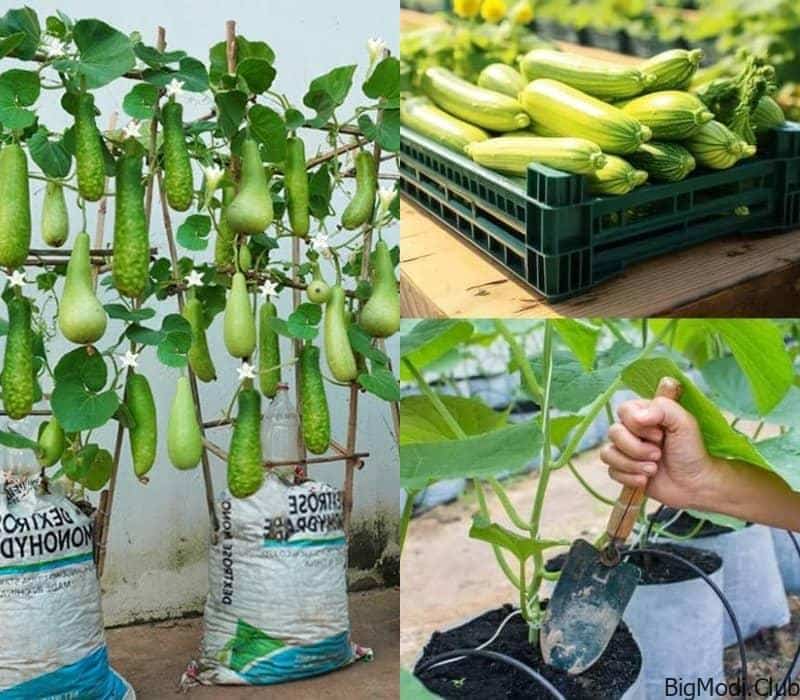Gourds are versatile plants that not only provide decorative value but also serve practical purposes, from birdhouses to exfoliating sponges. To successfully grow gourds, it’s essential to understand the nuances of planting, nurturing, and harvesting these unique plants. Whether you’re interested in growing them traditionally in garden beds or exploring the benefits of vertical gardening, mastering the art of how to grow gourds will help you achieve a fruitful and visually appealing harvest. In this guide, we will explore effective techniques and tips to ensure you know exactly how to grow gourds and get the most out of your gourd-growing experience.
How to Grow Gourds
Planting Gourds:
When it comes to planting gourds, timing and placement are crucial for a successful harvest. Start by planting your gourds directly in the garden after the last spring frost has passed. For optimal results, consider these planting methods:
- Hill Planting: Sow five seeds per hill, spacing the hills 4 feet apart. This method encourages better air circulation and larger gourd development.
- Row Planting: Alternatively, sow seeds 5 inches apart in rows that are set 5 to 10 feet apart. This approach is ideal for managing space in larger gardens.
As the seedlings emerge, thin them to leave three strong plants per hill. Remember, gourds thrive in warm weather and cannot tolerate frost. If late spring frosts threaten, be sure to protect your young plants to ensure they have a healthy start.
Growing Gourds:
Gourds are sun-loving plants that require full sunlight and ample water to flourish. While they generally grow best with minimal interference, positioning them near a fence or trellis can provide additional support. Gourds are vining plants, and this support helps them spread upward rather than outward, making them easier to manage and harvest.
Nutrient Needs:
Gourds are known for their robust appetite for nutrients. Before planting, enrich the soil with manure or compost to give your gourds a strong start. Once established, you may not need to fertilize further. However, if desired, a low-nitrogen, water-soluble fertilizer like 5-10-5 can be beneficial. Be cautious with high-nitrogen fertilizers, as they promote excessive leafy growth at the expense of fruit production.
Where to Buy Gourd Seeds:
If you’re looking to purchase gourd seeds, Urban Farmer offers a variety of options in different shapes, sizes, and colors. This is a great place to find the perfect seeds to suit your gardening goals.
Growing Gourds Vertically:
Why Grow Gourds Vertically:
For gardeners with limited space, growing gourds vertically is an excellent solution. Gourd vines are vigorous and can quickly take over a garden bed, making vertical growth on structures like trellises, fences, or pergolas not only practical but also aesthetically pleasing.
Types of Gourds:
- Hard Shell Gourds (Lagenaria siceraria): These durable gourds are perfect for crafting items like bottles, bowls, or birdhouses.
- Ornamental Gourds (Cucurbita pepo): Available in various shapes, sizes, and colors, these gourds are primarily used for decorative purposes.
- Sponge Gourds (Luffa cylindrica): Once dried, these gourds can be used as exfoliators or bath sponges.
Support Structures:
To support your vertical gourd garden, use strong and sturdy structures. Arbors, arches, pergolas, or wire fences work well. You can even create a gourd tunnel by shaping mesh or bamboo into an arch. These supports will help the vines climb and produce hanging gourds that are both functional and attractive.
Advantages of Vertical Growing:
Growing gourds vertically offers several benefits:
- Improved Air Circulation: By elevating the plants, you reduce the risk of fungal diseases like powdery mildew.
- Reduced Pest Issues: Plants are less susceptible to pests when grown off the ground.
- Better Gourd Shape: Long gourds grow straight, and large round gourds avoid flat spots.
- Easier Harvesting: Elevated gourds are more accessible, making harvesting less of a chore.
Planting Tips:
For successful vertical growth:
- Wait until after the last frost and ensure the soil is warm before planting.
- Start seeds indoors in early spring if needed, then transplant them once the frost risk has passed.
- Prepare the soil with aged compost to boost fertility.
- Plant seeds about 1 inch (2.5 cm) deep near your chosen support structure. Typically, one plant per small trellis is sufficient, as vines can grow up to 16 feet (4.8 meters) or more.
Growth and Maintenance:
Seeds generally sprout within 1 to 3 weeks, though this can be longer in cooler soil. As the vines grow, they produce long tendrils that naturally wrap around supports. Guide these tendrils around your trellis or wire to encourage upward growth. If the vines outgrow the support, trim them back to keep them manageable and ensure a bountiful harvest.
FAQs
Where Do Gourds Grow Naturally?
Gourds naturally grow in regions with a warm climate. They are members of the Cucurbitaceae family, which also includes pumpkins and squash. Gourds are found in both the Cucurbita genus (soft-skinned) and the Lagenaria genus (hard-skinned). While ornamental gourds are commonly grown in gardens for their decorative qualities, they can also be found growing naturally in a variety of environments, depending on the specific type.
How Long Does It Take for a Gourd to Grow?
The time it takes for a gourd to grow can vary depending on the variety. On average, it takes between 90 to 130 days for gourds to mature. Hard-shell varieties typically require more time compared to soft-skinned types. Generally, gourds are ready to harvest after the first frost in the fall, when the stems have browned and the gourds have fully developed.
Are Gourds Hard to Grow?
Gourds are relatively easy to grow, especially if you follow a few key guidelines. They prefer full sun, well-drained soil, and ample water. Some gardeners find that gourds thrive best with minimal interference, meaning you can plant them and let them grow with little intervention. However, they do need protection from frost and may require support if grown vertically.
How Many Gourds Will One Plant Produce?
The number of gourds produced by a single plant can vary widely depending on the gourd type and growing conditions. Typically, a healthy gourd plant can produce several gourds per vine. For example, ornamental gourds may yield anywhere from 5 to 15 gourds per plant, while hard-shell gourds and sponge gourds may produce fewer but larger fruits.
Can I Grow Gourds in Pots?
Yes, you can grow gourds in pots, though it requires some adjustments. Choose a large pot to accommodate the vigorous growth of gourd vines. Ensure the pot has good drainage and use a rich, well-draining soil mix. Gourds will still need a support structure, such as a trellis, to help them grow upwards and manage their space effectively. Keep in mind that the size of the pot may limit the number of gourds the plant can produce.


